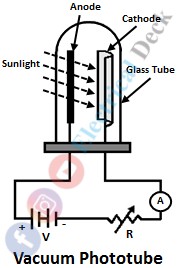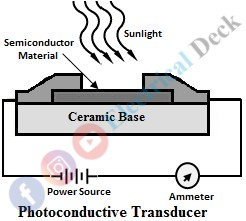What is Photoelectric Transducer?
The photoelectric transducer is a light-sensitive device used to convert light energy into electrical energy. It is made up of semiconductor material that emits electrons when a beam of light falls on it.
The light contains energized particles called photons when strikes the photosensitive element of the photoelectrical transducer. The energy of photons is converted into kinetic energy of the electrons in the semiconducting material, thus induces a current in the material.
Classification of Photoelectric Transducers :
The various photoelectric transducers that convert light energy into electrical energy are photoemissive transducer, photovoltaic transducer, photoconductive transducer, photodiode, and phototransistor.
Photoemissive Transduce or Cell :
The principle of working of a photo-emissive transducer is based on the emission of electrons when the transducer is exposed to sunlight. In some special combination of material like cesium-antimony, when it is exposed to sunlight, the photons of the light beam incident on the surface of the material causes electrons to break their atomic bonds and are emitted.
This phenomenon is called the Photo-emissive Effect. The arrangement consists of a glass tube in which photo-emissive material is enclosed. There are three types of photo-emissive transducers,
- Vacuum phototube
- Gas-filled phototube
- Photomultiplier tube.
Vacuum Phototube :
A vacuum phototube consists of an anode rod and a cathode plate enclosed in a vacuum glass tube. The cathode plate is coated with photoemissive material, which emits electrons when the light beam falls on it.
The electrons emitted are attracted by the anode rod by keeping the anode at positive potential. The amount of electrons emitted is proportional to the intensity of light. Thus the magnitude of current flowing in the circuit depends upon the intensity of incident light on the cathode.
Photomultiplier :
It is the most popular and most widely used photo-emissive transducer. The working of the photomultiplier is similar to the vacuum phototube, but the electrons emitted from the cathode are not immediately drawn to the anode. But they are made to attracted by another electrode called dynode D1.
Again the dynode D1 emits secondary electrons due to incident electrons of the cathode. These secondary electrons when strike dynode D2, it emits electrons which are finally collected by the anode. Thus electrons are multiplied in numbers at each dynode by secondary emission.
Photovoltaic Transducer or Cell :
A photovoltaic cell is also known as a solar cell. It is one of the photodetectors. It converts electromagnetic radiation into an electrical signal. The generated voltage at the output of the cell is proportional to the intensity of electromagnetic radiation.
Photovoltaic transducers operate on the principle of the Photovoltaic effect, i.e., when light strikes a junction of certain dissimilar metals, a voltage is generated. It is basically a PN-junction diode with appropriately doped semiconductors. The semiconductor materials that can be used in the cell are silicon, germanium, selenium, indium arsenide, antimonide.
When the cell is exposed to light, a voltage is generated across the junction. A different feature of this transducer is that it does not require any auxiliary power source. However, the output of the cell is low and is not a linear function of the input. The most common application of photovoltaic cells is in the light exposure meter in photographic work.
Advantages of Photovoltaic Transducer :
- They generate voltage without using any form of external source.
- They produce a fast response.
Applications of Photovoltaic Transducer :
- They can be used as energy converters.
- Used in space crafts, data processing industries, switching and trigger circuits, earth-based applications.
- Can be used to determine the width of material processing.
- Cells with gold doped germanium material can be used as infrared detectors.
Photoconductive Transducer or Cell :
Photoconductive cells or transducers are one type of photodetector. It works on the principle of photoconductive effect. When light strikes a semiconductor material, there is a decrease in the resistance of the material, thereby producing an increase in the current. Such materials which change their resistance when exposed to light are called photoconductive materials. Those materials are cadmium, selenide-lead sulfide, doped germanium, etc.
The cell consists of a thin layer of light-sensitive semiconductor material coated between two electrodes on a ceramic base as shown in the figure. An ammeter is incorporated into the circuit to measure the change in current in the circuit, in accordance with the change in resistance of the photoconductive cell.
When light rays fall on semiconductor material, charge carriers will be released which increases the flow of current in the circuit produced by the applied electrical field.
With an increase in the intensity of light, the resistance of semiconductor material decreases, thereby increasing current and vice versa. The change in the current with respect to the change in resistance is noted by an ammeter.
Advantages of Photoconductive Transducer :
- The photoconductive cell made up of cadmium sulfoselenide can be used in the infrared region.
- They can be operated using low voltages.
Disadvantages of Photoconductive Transducer :
- The resistance varies due to the change in temperature for particular light intensity.
- They cannot be used for analog applications.
Applications of Photoconductive Transducer :
- They are effectively sued in relay control circuits, burglar alarms, and light-controlled switches.
- They are used to measure the attenuation of light.
- In industrial control equipment to count the number of packages moving on conveyor belts etc.
Photodiode :
A photodiode acts as a light-sensitive device and converts the illuminated light into an electrical signal. Therefore, it is also known as a photodetector. It is formed by placing a semiconductor PN junction in a sealed glass or plastic casing such that the radiations of light are allowed to fall on the surface across the junction when illuminated.
The photodiode is connected in reverse bias condition and when there is no illumination a small leakage current of the order of a fraction of 1 μA flows across the junction. However, when the junction is properly illuminated the current raises. This increase in the current is directly proportional to the intensity of light rays.
Therefore, this linearity is maintained by maintaining the bias voltage at a constant value. In the dark condition, a small leakage current called a dark current will flow through the diode.
Advantages of Photodiode :
- They possess a good frequency response compared to photoconductors.
- They produce a spectral response.
- They have good linearity.
- The problem of noise is low.
Disadvantages of Photodiode :
- The active area of the photodiode is very small.
- Requirement of bias voltage to maintain the linearity over a wide range.
- The dark current increases rapidly with an increase in temperature.
- If the illumination level is low then a very low voltage is available at the output which needs amplification.
Applications of Photodiode :
- Photodiodes are widely used in high-quality light meters and demodulations.
- Since the response time of photodiodes is very fast, they are used in film soundtrack recorders.
- They are used in optical communication systems to detect the modulated light.
Phototransistor :
Phototransistors are similar to regular NPN or PNP or FET transistors with three layers but with a light-sensitive base region as shown below. The working is similar to a normal transistor but there is no electrical connection to the base region and the base current is obtained from light energy.
The input is given to the collector and output is obtained from the emitter. When the light beam strikes the base region of the phototransistor. It generates electron-hole pairs which give rise to base current under the influence of the applied electric field.
Under the dark condition, there is no base current produced but a small leakage current (order of nA) will flow from collector to emitter known as dark current. As the light intensity increases, the base current increases, which in turn increases the collector current. The base current produced is directly proportional to the light intensity.






